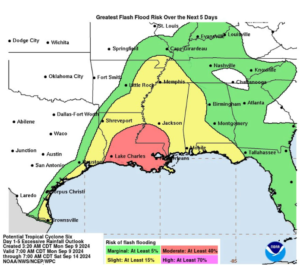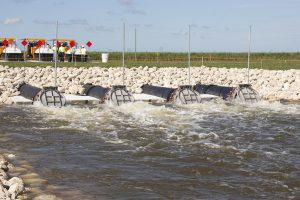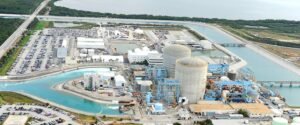Plus, a pending water shortage, nuclearization
 The National Weather Service is experimenting with a flood hazard outlook, Florida is expected to enter a significant water supply shortage by 2025, and new discussions about adding more nuclear power to the Sunshine State’s energy portfolio. It’s all in this week’s Environmental and Engineering Digest.
The National Weather Service is experimenting with a flood hazard outlook, Florida is expected to enter a significant water supply shortage by 2025, and new discussions about adding more nuclear power to the Sunshine State’s energy portfolio. It’s all in this week’s Environmental and Engineering Digest.
 Flood Hazard Outlook: Hurricane Francine’s Louisiana landfall last week with its soaking rains across the Southeast U.S. provided a good test for the National Weather Service’s latest product. The experimental Flood Hazard Outlook (FHO) provides a graphic display to alert inland areas to potential flash-flooding and river impacts over a 7-day period. The tool was designed specifically to let users select specific areas and see varying flood intensities ranging from catastrophic, considerable, or limited impacts indicated by a color-coded map. The FHO will work in conjunction with other National Weather Service products like the Excessive Rainfall Outlook to gather the most accurate and up to date information on water levels and river impacts. You can view the FHO product here.
Flood Hazard Outlook: Hurricane Francine’s Louisiana landfall last week with its soaking rains across the Southeast U.S. provided a good test for the National Weather Service’s latest product. The experimental Flood Hazard Outlook (FHO) provides a graphic display to alert inland areas to potential flash-flooding and river impacts over a 7-day period. The tool was designed specifically to let users select specific areas and see varying flood intensities ranging from catastrophic, considerable, or limited impacts indicated by a color-coded map. The FHO will work in conjunction with other National Weather Service products like the Excessive Rainfall Outlook to gather the most accurate and up to date information on water levels and river impacts. You can view the FHO product here.
 Impending Water Supply Shortage: Florida’s population and economic growth have sweeping implications for the future – including the beginning of a water shortage that may come to the state as early as 2025. A recent analysis of the water supply found that Florida will need nearly $2 billion in critical water projects to avoid outpacing current resources. Florida TaxWatch, a nonprofit research institute analyzed projections from the Florida Office of Economic and Demographic Research and issued a report, finding that water consumption levels statewide will largely be unsustainable within a couple years. Officials have ideas, like expanding desalination plants, or building larger reservoirs, but it can take up to a decade to put a new water facility online, from planning and permitting all the way to launch. TaxWatch said many current projects, while worthwhile, circumvent the competitive review process and take dollars away from higher-priority projects…and the current system of funding (grants and legislators’ member projects) doesn’t have the consistency needed for a comprehensive, coordinated statewide strategy.
Impending Water Supply Shortage: Florida’s population and economic growth have sweeping implications for the future – including the beginning of a water shortage that may come to the state as early as 2025. A recent analysis of the water supply found that Florida will need nearly $2 billion in critical water projects to avoid outpacing current resources. Florida TaxWatch, a nonprofit research institute analyzed projections from the Florida Office of Economic and Demographic Research and issued a report, finding that water consumption levels statewide will largely be unsustainable within a couple years. Officials have ideas, like expanding desalination plants, or building larger reservoirs, but it can take up to a decade to put a new water facility online, from planning and permitting all the way to launch. TaxWatch said many current projects, while worthwhile, circumvent the competitive review process and take dollars away from higher-priority projects…and the current system of funding (grants and legislators’ member projects) doesn’t have the consistency needed for a comprehensive, coordinated statewide strategy.

Courtesy FPL
Florida Goes Nuclear: Not only will the future of the Sunshine State require more water, but new additions to its energy portfolio as well. Earlier this month, nuclear power and its place in Florida’s energy generation were discussed at a workshop hosted by the Florida Public Service Commission (PSC). Legislative directives (HB 1645) passed earlier this year require the PSC to evaluate the technical and economic feasibility of using nuclear power technologies, including small modular reactors, and to research ways to encourage use of such technologies at military installations in partnership with public utilities. About 75% of all energy consumed in Florida comes from natural gas (a larger proportion from one energy source than any other state) and with rising prices, policymakers are interested in diversifying. Nuclear energy in Florida currently supplies 13% of our energy needs. While safety has traditionally been the main concern from its opponents, its proponents are adamant there is plenty of data showing that nuclear energy is (and always has been) the safest form of power production. This June, the Biden Administration signed the ADVANCE Act into law to help expedite the process of nuclearization, reducing the barriers to entry and increasing reactor deployment across the country.
LMA Newsletter of 9-16-24

